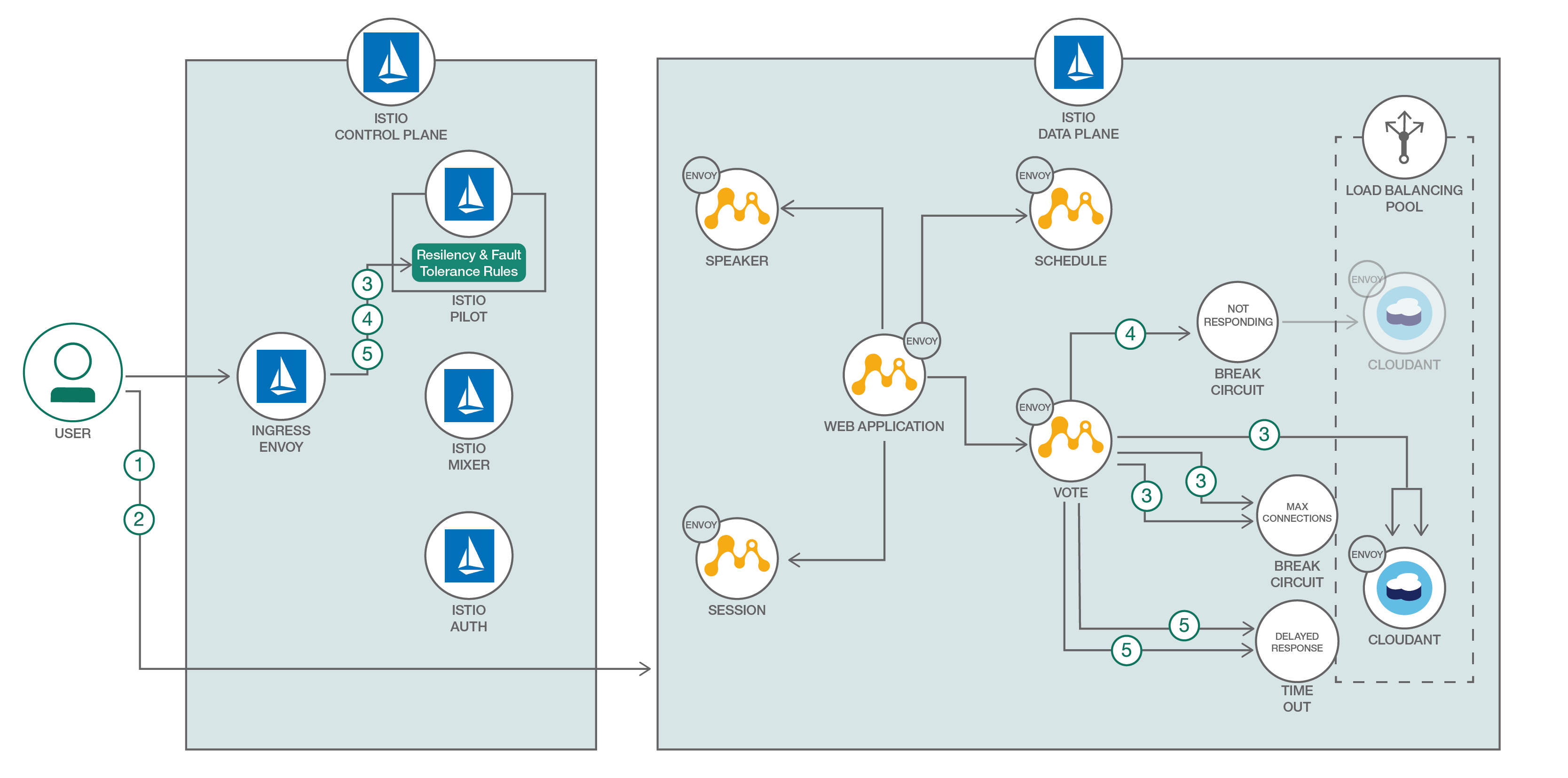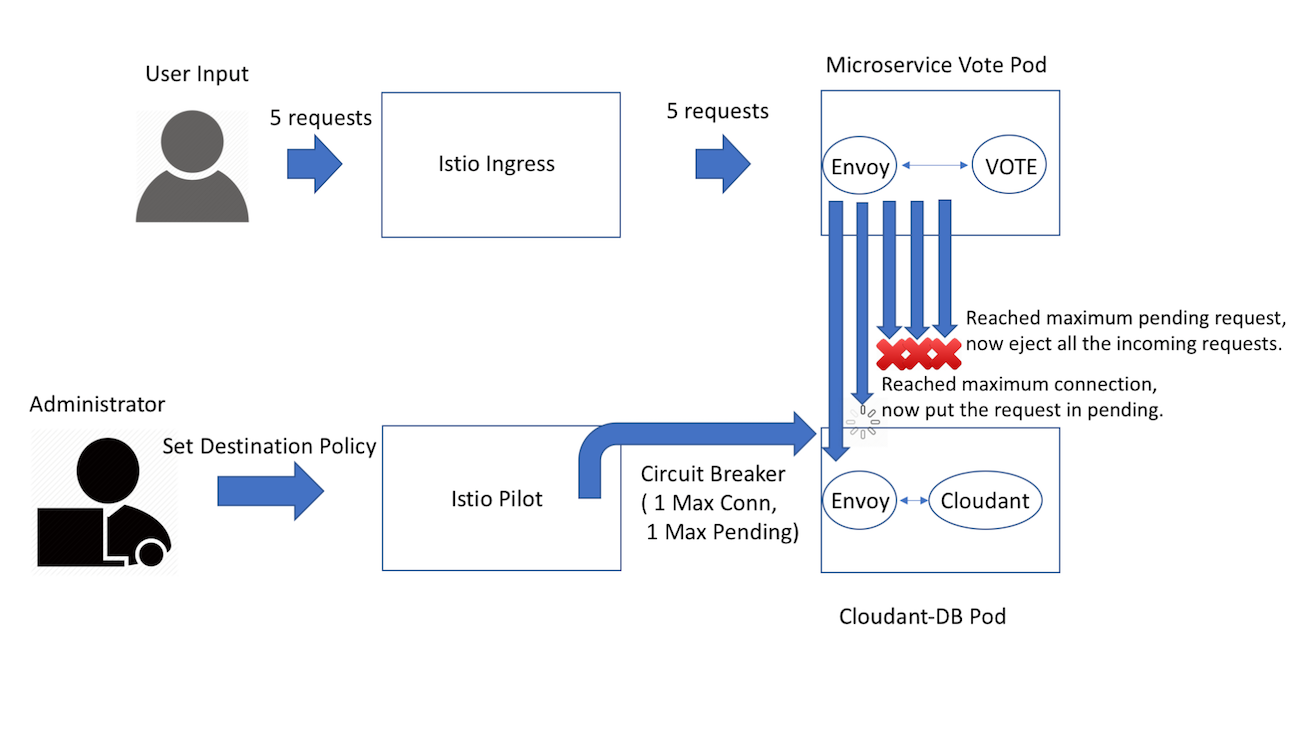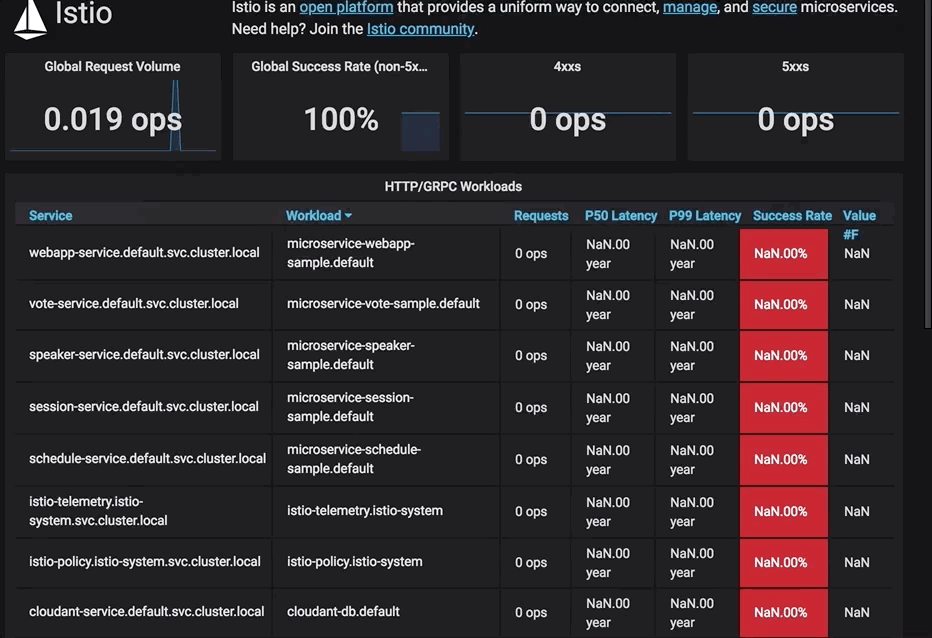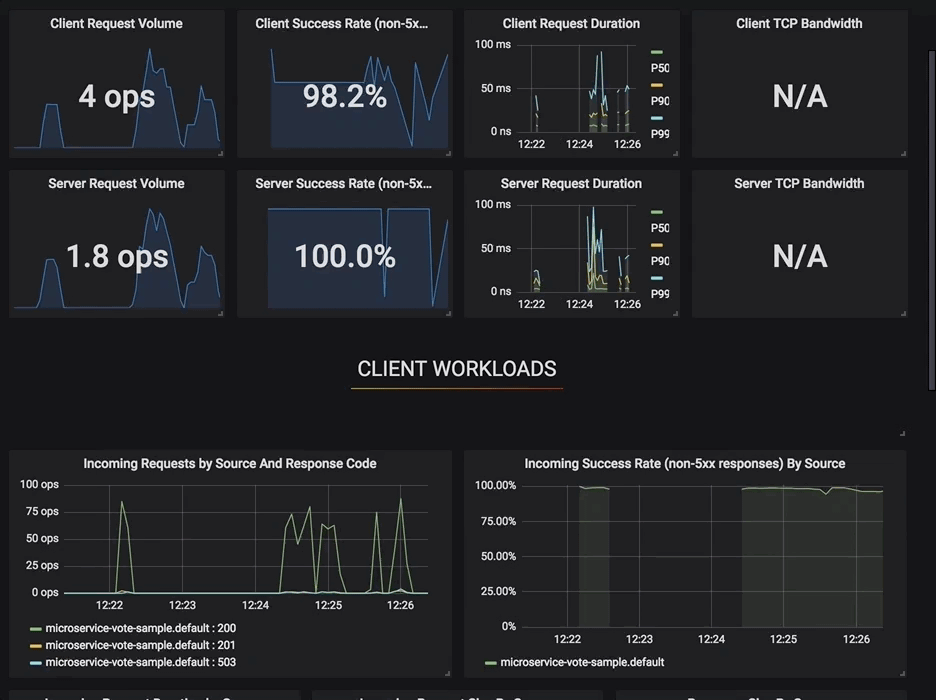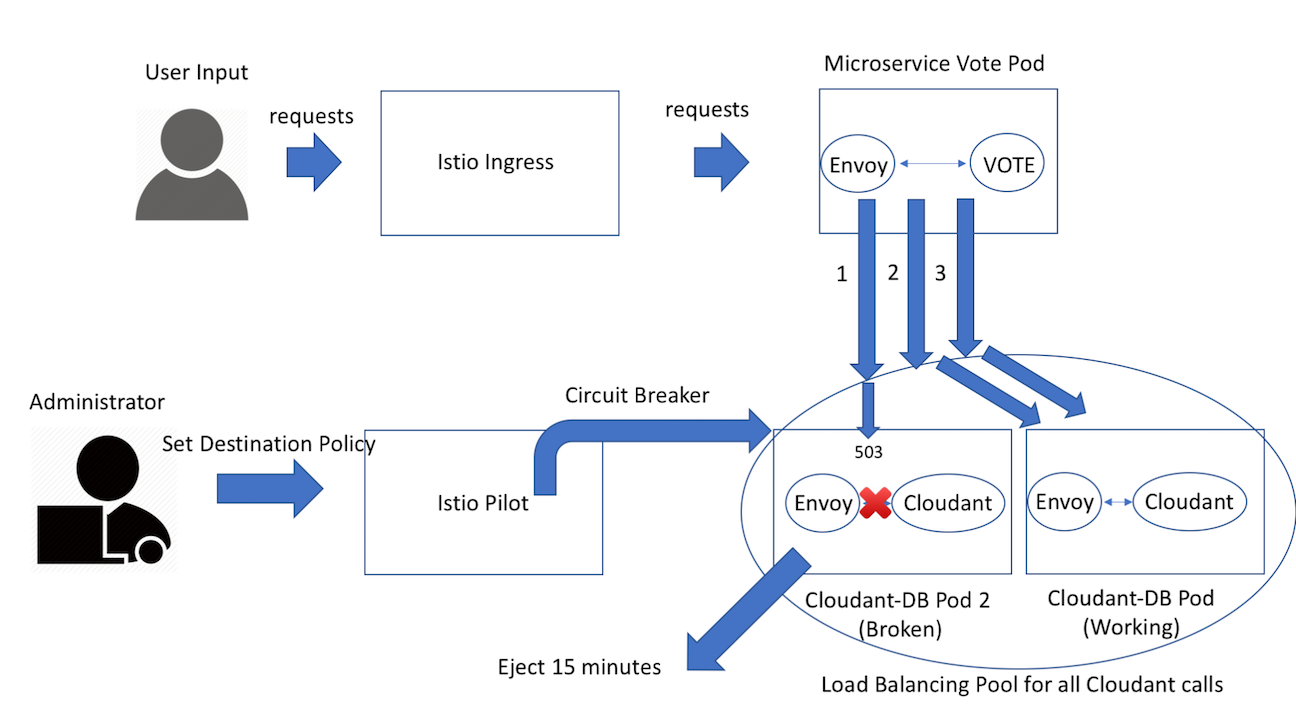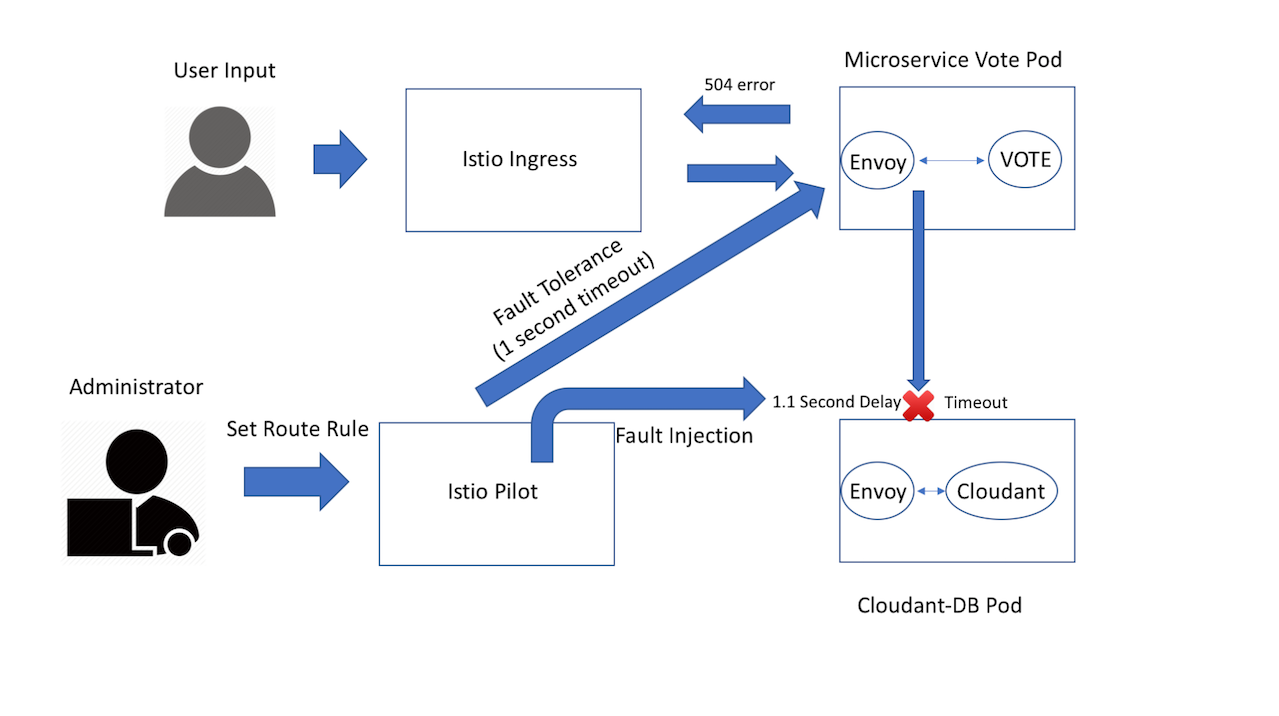Read this in other languages: 한국어.
Building and packaging Java microservice is one part of the story. How do we make them resilient? How do we introduce health checks, timeouts, retries, ensure request buffering or reliable communication between microservices? Some of these features are coming built in microservices framework, but often they are language specific, or you have to accommodate for it in your application code. How do we introduce it without changing the application code? Service-mesh architecture attempts to solve these issues. Istio provides an easy way to create this service mesh by deploying a control plane and injecting sidecars containers alongside your microservice.
In this pattern we demonstrate how to build and deploy your Java MicroProfile microservices leveraging Istio service mesh. MicroProfile is a baseline Java platform for a microservices architecture and delivers application portability across multiple MicroProfile runtimes - the initial baseline is JAX-RS plus CDI plus JSON-P. It provides specs for building and packaging Java microservices in a standardized way.
We then show how to configure and use circuit breakers, health checks and timeouts/retries resiliency features for the application.
Resiliency and fault tolerance: Istio adds fault tolerance to your application without any changes to code. Some resiliency features it supports are:
- Retries/Timeouts
- Circuit breakers
- Health checks
- Control connection pool size and request load
- Systematic fault injection
We use the sample MicroProfile web application for managing a conference and it is based on a number of discrete microservices. The front end is written in Angular; the backing microservices are in Java. All run on Open Liberty, in Docker containers managed by Kubernetes.
MicroProfile Fault Tolerance, adding application-specific capabilities such as failback functions that can work in conjunction with, or independently from, Istio capabilities will be the subject of a future update.
- Create a Kubernetes cluster with either Minikube for local testing, with IBM Cloud Private, or with IBM Cloud Kubernetes Service to deploy in cloud. The code here is regularly tested against Kubernetes Cluster from IBM Cloud Kubernetes Service using Travis.
- You will also need Istio service mesh installed on top of your Kubernetes cluster. Please follow the instructions, Istio Quick Start, to get Istio mesh installed on Kubernetes. For the purposes of this pattern, you can follow the instructions in "Option 1" in the Quick Start documentation.
- Circuit Breakers - Maximum connections and pending requests
- Circuit Breakers - Load balancing pool ejection
- Timeouts and Retries
If you don't want to build your own images, you can use our default images and move on to Step 2.
Note that if you would like to experiment with new features available in the latest releases of Open Liberty, consider rebuilding the microservices images yourself first.
Before you proceed to the following instructions, make sure you have Maven and Docker installed on your machine.
First, clone and get in our repository to obtain the necessary yaml files and scripts for downloading and building your applications and microservices.
git clone https://github.com/IBM/resilient-java-microservices-with-istio.git
cd resilient-java-microservices-with-istioNow, make sure you login to Docker first before you proceed to the following step.
Note: For the following steps, you can get the code and build the package by running
./scripts/get_code_linux.sh [docker username] #For Linux users ./scripts/get_code_osx.sh [docker username] #For Mac usersThen, you can move on to Step 2.
git clone and mvn clean package the following projects:
git clone https://github.com/IBM/sample.microservices.web-app.git git clone https://github.com/IBM/sample.microservices.schedule.git git clone https://github.com/IBM/sample.microservices.speaker.git git clone https://github.com/IBM/sample.microservices.session.git git clone https://github.com/IBM/sample.microservices.vote.gitmvn clean packagein each ../sample.microservices.* projects
Now, use the following commands to build the microservice containers.
Build the web-app microservice container
docker build -t <docker_username>/microservice-webapp sample.microservices.web-app
docker push <docker_username>/microservice-webappBuild the schedule microservice container
docker build -t <docker_username>/microservice-schedule sample.microservices.schedule
docker push <docker_username>/microservice-scheduleBuild the speaker microservice container
docker build -t <docker_username>/microservice-speaker sample.microservices.speaker
docker push <docker_username>/microservice-speakerBuild the session microservice container
docker build -t <docker_username>/microservice-session sample.microservices.session
docker push <docker_username>/microservice-sessionBuild the vote microservice container
docker build -t <docker_username>/microservice-vote-cloudant sample.microservices.vote
docker push <docker_username>/microservice-vote-cloudantThe great thing about Istio is you can deploy your application on Istio without changing any of your files. However, the original MicroProfile example is built on top of the Fabric (an extra infrastructure services on top of Kubernetes). Therefore, you need to deploy the application with the yaml files in this repository.
Before you proceed to the following steps, change the journeycode in your yaml files to your own docker username if you want to use your own docker images.
Note: If you ran the get_code script, your docker username is already changed in your yaml files.
Envoys are deployed as sidecars on each microservice. Injecting Envoy into your microservice means that the Envoy sidecar would manage the ingoing and outgoing calls for the service. To inject an Envoy sidecar into an existing microservice configuration, do:
#First we Create a secret for cloudant credential
kubectl create secret generic cloudant-secret --from-literal=dbUsername=admin --from-literal=dbPassword=$(LC_CTYPE=C < /dev/urandom tr -dc _A-Z-a-z-0-9 | head -c${1:-32};echo;)
kubectl apply -f <(istioctl kube-inject -f manifests/deploy-schedule.yaml)
kubectl apply -f <(istioctl kube-inject -f manifests/deploy-session.yaml)
kubectl apply -f <(istioctl kube-inject -f manifests/deploy-speaker.yaml)
kubectl apply -f <(istioctl kube-inject -f manifests/deploy-cloudant.yaml)
kubectl apply -f <(istioctl kube-inject -f manifests/deploy-vote.yaml)
kubectl apply -f <(istioctl kube-inject -f manifests/deploy-webapp.yaml)After a few minutes, you should now have your Kubernetes Pods running and have an Envoy sidecar in each of them alongside the microservice. The microservices are schedule, session, speaker, vote, cloudant, and webapp.
$ kubectl get pods
NAME READY STATUS RESTARTS AGE
cloudant-db-4102896723-6ztmw 2/2 Running 0 1h
microservice-schedule-sample-971365647-74648 2/2 Running 0 2d
microservice-session-sample-2341329899-2bjhg 2/2 Running 0 2d
microservice-speaker-sample-1294850951-w76b5 2/2 Running 0 2d
microservice-vote-sample-3728755778-5c4vx 2/2 Running 0 1h
microservice-webapp-sample-3875068375-bvp87 2/2 Running 0 2dTo access your application, you need to create an Istio Gateway to connect all the microservices and access it. Thus, do:
istioctl create -f manifests/istio-gateway.yamlYou can check the public IP address of your IBM Cloud cluster through bx cs workers <your_cluster_name> and get the NodePort of the istio-ingress service for port 80 through kubectl get svc -n istio-system | grep istio-ingress. Or you can also run the following command to output the IP address and NodePort:
echo $(bx cs workers <your_cluster_name> | grep normal | awk '{ print $2 }' | head -1):$(kubectl get svc istio-ingressgateway -n istio-system -o jsonpath='{.spec.ports[0].nodePort}')
# Replace <your_cluster_name> with your cluster name. This should output your IP:NodePort e.g. 184.172.247.2:30344Point your browser to:
http://<IP:NodePort> Replace <IP:NodePort> with your own IP and NodePort.
Congratulations, you MicroProfile application is running and it should look like this.
Circuit breaking is a critical component of distributed systems. It’s nearly always better to fail quickly and apply back pressure downstream as soon as possible. Envoy enforces circuit breaking limits at the network level as opposed to having to configure and code each application independently.
Now we will show you how to enable circuit breaker for the sample Java microservice application based on maximum connections your database can handle.
Before we move on, we need to understand these different types of Circuit Breaker:
- Maximum Connections: Maximum number of connections to a backend. Any excess connection will be pending in a queue. You can modify this number by changing the
maxConnectionsfield. - Maximum Pending Requests: Maximum number of pending requests to a backend. Any excess pending requests will be denied. You can modify this number by changing the
http1MaxPendingRequestsfield.
Now take a look at the circuit-breaker-db.yaml file in manifests. We set Cloudant's maximum connections to 1 and Maximum pending requests to 1. Thus, if we sent more than 2 requests at once to cloudant, cloudant will have 1 pending request and deny any additional requests until the pending request is processed. Furthermore, it will detect any host that triggers a server error (5XX code) in the Cloudant's Envoy and eject the pod out of the load balancing pool for 15 minutes. You can visit here to check out more details for each field.
apiVersion: networking.istio.io/v1alpha3
kind: DestinationRule
metadata:
name: db-circuit
namespace: default
spec:
host: cloudant-service
trafficPolicy:
connectionPool:
tcp:
maxConnections: 1
http:
http1MaxPendingRequests: 1
maxRequestsPerConnection: 1
outlierDetection:
consecutiveErrors: 1
interval: 1s
baseEjectionTime: 15m
maxEjectionPercent: 100
The following Grafana dashboard animation shows votes being clicked prior to the circuit breaker rule being applied.
Note: Grafana can be set up by following the instructions in this related code pattern: Manage microservices traffic using Istio.
Create a circuit breaker policy on your cloudant service.
istioctl create -f manifests/circuit-breaker-db.yamlNow point your browser to: http://<IP:NodePort>, enable your developer mode on your browser, and click on network. Go to Speaker or Session and try to vote 5 times within a second. Then, you should see the last 2 to 3 vote will return a server error because there are more than one pending request get sent to cloudant. Therefore, the circuit breaker will reject the rest of the requests.
When viewing the logs of the vote microservice pod, you would see these errors from the Liberty runtime when the limit being enforced by Istio has been reached and calls to the database start to fail:
[WARNING ] Application {http://api.vote.showcase.microprofile.io/}SessionVote has thrown exception, unwinding now
Unable to execute request: 503 : upstream connect error or disconnect/reset before headers
[WARNING ] Exception in handleFault on interceptor org.apache.cxf.jaxrs.interceptor.JAXRSDefaultFaultOutInterceptor@8527bddd
Unable to execute request: 503 : upstream connect error or disconnect/reset before headers
[ERROR ] Error occurred during error handling, give up!
Unable to execute request: 503 : upstream connect error or disconnect/reset before headers
[ERROR ] SRVE0777E: Exception thrown by application class 'io.microprofile.showcase.vote.persistence.couch.CouchConnection.request:179'
io.microprofile.showcase.vote.persistence.couch.RequestStatusException: Unable to execute request: 503 : upstream connect error or disconnect/reset before headers
at io.microprofile.showcase.vote.persistence.couch.CouchConnection.request(CouchConnection.java:179)
at io.microprofile.showcase.vote.persistence.couch.CouchConnection.request(CouchConnection.java:123)The animation below shows what you would see with votes being sent quickly enough to trip the circuit breaker rule:
Note: using fault injection or a mixer rule will not be able to trigger the circuit breaker because all the traffic will be aborted/delayed before it is sent to the cloudant's Envoy.
Note: We will use the same circuit breaker policy from the previous step.
A load balancing pool is a set of instances that are under the same Kubernetes service, and envoy distributes the traffic across those instances. If some of those instances are broken, the circuit breaker can eject any broken pod in your load balancing pool to avoid any further failure. To demonstrate this, create a new cloudant database instance, cloudant-db pod 2, that listens to the wrong host.
kubectl apply -f <(istioctl kube-inject -f manifests/deploy-broken-cloudant.yaml)To better test the load balancing pool ejection, you don't want the circuit breaker to eject requests for maximum connection and pending requests. Hence, remove or comment out this block:
connectionPool:
tcp:
maxConnections: 1
http:
http1MaxPendingRequests: 1
maxRequestsPerConnection: 1
inside manifests/circuit-breaker-db.yaml and run
istioctl replace -f manifests/circuit-breaker-db.yamlNow go to the MicroProfile example on your browser and vote on any session. Then you will see the first vote will return a 500 server error because the cloudant-db pod 2 is broken. However, the circuit breaker will detect that error and eject that broken cloudant pod out of the pool. Thus, if you keep voting within the next 15 minutes, none of that traffic will go to the broken cloudant because it won't return to the pool until 15 minutes later.
You can double check the broken cloudant only received the traffic once.
kubectl get pods # check your cloudant-db-second name
kubectl logs cloudant-db-second-xxxxxxx-xxxxx istio-proxy --tail=150 # You can replace 150 with the number of logs you like to display.As you can see, there will only be one HTTP call within the logs.
Before you move to the next step, please remove the broken cloudant and circuit breaker policy.
kubectl delete -f manifests/deploy-broken-cloudant.yaml
istioctl delete -f manifests/circuit-breaker-db.yamlHere's an example to demonstrate how can you add resiliency via timeouts in your application. First, we want to create a 1-second timeout to the vote service, so the vote service can stop listening if cloudant is not responding within 1-second.
Then, in order to make sure we can trigger and test this, we will inject a more than 1-second delay to cloudant, so the vote service will timeout for each response from cloudant. This process is called Fault Injection, where essentially we are introducing faults to our paths for testing and improve error handling.
Now take a look at the istio-gateway-vote-timeout file in manifests.
---
apiVersion: networking.istio.io/v1alpha3
kind: VirtualService
metadata:
name: microservice-main-routes
spec:
...
http:
- match:
- uri:
prefix: /vote
route:
- destination:
host: vote-service
port:
number: 9080
timeout: 1s ## Additional configuration
...We are adding timeout in our main route to vote-service. This rule will timeout all the responses that take more than 1 second in the vote service. You can modify timeout to add more time for your timeout. Then do:
istioctl replace -f manifests/istio-gateway-vote-timeout.yamlIn order to test our timeout rule is working properly, we need to apply some fault injections. Thus, take a look at the fault-injection.yaml in manifests.
---
apiVersion: networking.istio.io/v1alpha3
kind: VirtualService
metadata:
name: cloudant-service
spec:
hosts:
- cloudant-service
http:
- fault:
delay:
percent: 100
fixedDelay: 1.1s
route:
- destination:
host: cloudant-serviceThis rule will inject a fixed 1.1-second delay on all the requests going to Cloudant. You can modify percent and fixedDelay to change the probability and the amount of time for delay. Now let's apply a 1.1-second delay on the cloudant service to trigger your Vote service timeout.
istioctl create -f manifests/fault-injection.yamlNow point your browser to: http://<IP:NodePort>
Next, enable your developer mode on your browser and click on network. Then, click Vote on the microprofile site. Now you should able to see a 504 timeout error for the GET request on http://<IP:NodePort>/vote/rate since cloudant needs more than one second to response back to the vote service.
- To delete Istio from your cluster, run the following commands in your istio directory
kubectl delete -f install/kubernetes/istio-demo.yaml
kubectl delete -f install/kubernetes/istio-demo-auth.yaml # If you installed Istio with this yaml file- To delete your microprofile application, run the following commands in this Github repo's main directory
kubectl delete -f manifests- To delete your route rule or destination policy, run the following commands in this Github repo's main directory
istioctl delete -f manifests/<filename>.yaml #Replace <filename> with the rule/policy file name you want to delete.- If you have trouble with the maven build, your maven might have some dependency conflicts. Therefore, you need to purge your dependencies and rebuild your application by running the following commands
mvn dependency:purge-local-repository
mvn clean package- Your microservice vote will use cloudantDB as the database, and it will initialize the database on your first POST request on the application. Therefore, when you vote on the speaker/session for your first time, please only vote once within the first 10 seconds to avoid causing a race condition on creating the new database.
This Java MicroProfile codebase is based on WebSphere Liberty's MicroProfile Showcase Application
This code pattern is licensed under the Apache Software License, Version 2. Separate third party code objects invoked within this code pattern are licensed by their respective providers pursuant to their own separate licenses. Contributions are subject to the Developer Certificate of Origin, Version 1.1 (DCO) and the Apache Software License, Version 2.
